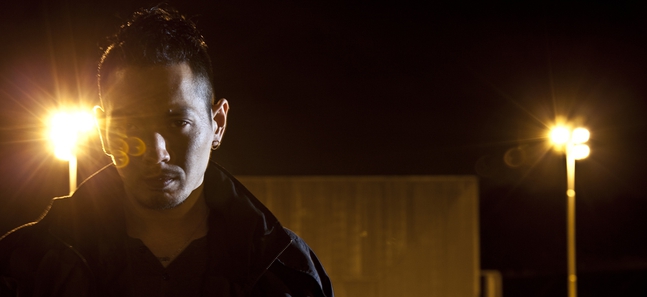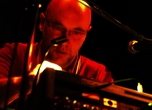Goth-Trad: the interview
It’s a ‘New Epoch’ for Japan’s most famous dubstep producer

Posted: Thu Jan 26 2012
It’s not quite monkeys and typewriters, but it’s close enough. Over the past five or six years, we’ve seen dubstep move from niche underground movement to a gaudy crossover success in which it’s become the music of choice for US rappers and nu-metal dunderheads Korn. But back when the bass-centric dance music was just beginning to extend its tendrils beyond a few select clubs in South London and Bristol, a Japanese producer named Takeaki Maruyama – aka Goth-Trad – accidentally discovered it all by himself.
Lurking amongst the potent genre mutations on Goth-Trad’s 2005 Mad Raver’s Dance Floor album was a track called ‘Back To Chill’, whose claustrophobic, bottom-heavy skank sounded remarkably similar to the music then being made by key producers like Loefah and Digital Mystikz in England. It was dubstep, all right. Maruyama just didn’t know there was a name for it yet.
‘I didn’t set out planning to make “dubstep”,’ he tells Time Out over coffee and cigarettes in a Shibuya café, where we’ve met to talk about his blistering 2012 album, New Epoch. ‘I was making grime instrumentals at the time – I thought [MC and producer] Wiley’s instrumentals were sweet.’ When he crossbred these sounds with another of his loves, abstract hip hop (‘I was just going for something dubbier,’ he says), he found himself in step with a community of producers he’d never heard of, living thousands of miles away. Funny, that.
A ravenous music consumer since his early teens, Maruyama had already covered a fair swathe of stylistic ground by this point. As Goth-Trad, he’d progressed from leftfield hip hop to experimental noise, while also honing a virile brand of electro-dub in Rebel Familia, his duo with Dry & Heavy bassist Takeshi ‘Heavy’ Akimoto. When his second album – the wholly improvised The Inverted Perspective (2005) – exhausted his appetite for abstract ear-shredding, he let his dance influences take control on Mad Raver’s, which united his obsession with the UK grime scene and his earlier enthusiasm for The Prodigy, drum ‘n’ bass and LFO.
But it was ‘Back To Chill’ that suggested where he might head next. The track began to garner buzz on MySpace and Dubstepforum.com, then the go-to online hub for dubstep enthusiasts, and Maruyama quickly started making friends overseas. By September 2006, he was launching his own monthly dubstep night in Tokyo – called, predictably, Back To Chill – and getting a proper taste of British bass-manship at the pivotal FWD>> club event in London, where he met his future label boss, Digital Mystikz member Mala.
Maruyama says that his experiences overseas had a powerful effect on his music, not least in his decision to start DJing – a temptation that he'd hitherto resisted. ‘In 2006, people in the Japanese underground scene didn’t think that DJs could also be producers, whereas over there it was totally normal for them to make their own tracks,' he says. ‘That was one of my motivations for starting DJing myself… When I peeped in Mala’s record bag, it was nearly all dubplates’ – the one-off acetates beloved of dub sound systems of yore – ‘which cost about ¥10,000 each. He’d have them cut just for his own use: it’s on a par with hearing someone play live.’
In 2007, Goth-Trad released the first in what would become a series of 12-inches on Mala’s Deep Medi Musik imprint, establishing his reputation as Japan’s preeminent – and, as far as most of the world were concerned, only – dubstep producer. He now spends a few months of each year touring overseas, which might explain why it’s taken him so long to produce a full-length successor to Mad Raver’s.
Or not. ‘By 2009 or 2010, I probably had about 20 unreleased tracks that I could've used on an album, but I didn't have that one tune that would hold it all together,’ he says. It was the album's eventual title track that clinched things: an epic excursion in undulating basslines and gauzy synthesizers that’s the most futurist(ic) thing he’s done to date. From there, everything else fell into place. ‘When I finished “New Epoch” last year, that gave me the vantage point I needed – to decide which other tracks made the cut, and which ones didn’t.’
Still, six-and-a-bit years is a long gap in any discography, especially one for an artist who's pledged allegiance to such a fast-evolving genre. New Epoch finds Goth-Trad in an odd position: after unintentionally latching on to dubstep just as it was beginning to take off, he’s returning to it now to find a scene that’s all but completely enervated. Many of the producers who pioneered the music have since distanced themselves from it, ceding ground to producers including Rusko and Skrillex, whose monocellular ‘brostep’ bangers sound more like exaggerated parodies.
‘I think the general idea of what dubstep is has changed a lot in the past couple of years,’ says Maruyama. ‘Nowadays, someone will listen to a tune on laptop speakers and say, “Oh, it’s got that beat and that mid-range bass sound, so it must be dubstep.” But they can’t even hear the most important part’ – referring to the enveloping sub-bass that, to his mind, is one of the music’s defining characteristics.
Goth-Trad productions can seem almost catholic in comparison, but if the tracks on New Epoch often hark back to dubstep’s first creative flowering, circa 2006-7, that’s not necessarily a bad thing. ‘I think dubstep fans now have got sick of that commercial, brostep sound,’ Maruyama says. ‘A lot of people were probably already bored of it last year, or the year before. If I’d released this album at the peak of that, in 2009, it would’ve been buried.’
When he says that younger producers like Compa and Kahn are more ‘in touch with the soul of early dubstep’, it's tempting to wonder: does he see a permanent fissure developing, between the ‘purist’ fans and their Jekyll-like brostep counterparts? ‘Yeah, I do,’ he says. ‘But I want to snag the fans on the other side. I want them to know what they’re missing out on.’
Goth-Trad plays at Back To Chill, February 2 and the New Epoch release party, February 18, both at Club Asia
Tweets
- About Us |
- Work for Time Out |
- Send us info |
- Advertising |
- Mobile edition |
- Terms & Conditions |
- Privacy policy |
- Contact Us
Copyright © 2014 Time Out Tokyo














Add your comment